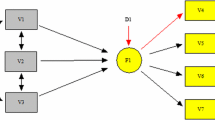Abstract
An approximation to the sampling distribution of Kuder-Richardson reliability formula 20 is derived, using its algebraic equivalent obtained through an items-by-subjects analysis of variance. The theoretical distribution is compared to empirical estimates of the sampling distribution to assess how crucial certain assumptions are. The use of the theoretical distribution for testing hypotheses and deriving confidence intervals is illustrated. A table of equations for approximating 80, 90, and 95 per cent confidence intervals is presented withN ranging from 40 to 500.
Similar content being viewed by others
References
Baker, F. B.Empirical determination of sampling distributions of item discrimination indices and a reliability coefficient. Madison, Wisc.: Univ. Wisconsin, 1962.
Blackburn, H. L. and Benton, A. L. Revised administration and scoring of the digit span test.J. consult. Psychol., 1957,21, 139–143.
Craig, A. T. On the independence of certain estimates of variance.Ann. math. Statist., 1938,9, 48–55.
Cronbach, L. J. Coefficient alpha and the internal structure of tests.Psychometrika, 1951,16, 297–334.
Dixon, W. J. and Massey, F. J.Introduction to statistical analysis. (2nd ed.) New York: McGraw-Hill, 1957.
Ebel, R. L. Estimation of the reliability of ratings.Psychometrika, 1951,16, 407–424.
Gulliksen, H.Theory of mental tests. New York: Wiley, 1950.
Haggard, E. A.Intraclass correlation and the analysis of variance. New York: Dryden Press, 1958.
Hoyt, C. Test reliability obtained by analysis of variance.Psychometrika, 1941,6, 153–160.
Huntsberger, D. V.Elements of statistical inference. Boston: Allyn and Bacon, 1961.
Jackson, R. W. B. and Ferguson, G. A.Studies on the reliability of tests. Bulletin No. 12, Depart. Educ. Res., Ontario College of Education. Toronto: Univ. Toronto Press, 1941.
Kuder, G. F. and Richardson, M. W. The theory of the estimation of test reliability.Psychometrika, 1937,2, 151–160.
Lindquist, E. F.Design and analysis of experiments in psychology and education. Boston: Houghton Mifflin, 1953.
Lindquist, E. F. (Ed.)Educational measurement. Washington, D.C.: American Council on Education, 1951.
Lord, F. M. Sampling fluctuations resulting from the sampling of test items.Psychometrika, 1955,20, 1–22.
Lord, F. M. An empirical study of the normality and independence of errors of measurement in test scores.Psychometrika, 1960,25, 91–104.
Mollenkopf, W. G. Variation of the standard error of measurement.Psychometrika, 1949,14, 189–229.
Smith, J. G. and Duncan, A. J.Sampling statistics and applications. New York: McGraw-Hill, 1945.
Author information
Authors and Affiliations
Rights and permissions
About this article
Cite this article
Feldt, L.S. The approximate sampling distribution of Kuder-Richardson reliability coefficient twenty. Psychometrika 30, 357–370 (1965). https://doi.org/10.1007/BF02289499
Received:
Revised:
Issue Date:
DOI: https://doi.org/10.1007/BF02289499




